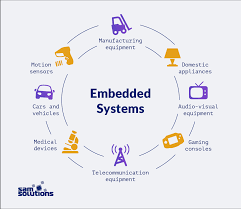
The Importance of Embedded Software Development in Modern Technology
Embedded software development plays a crucial role in the functioning of many modern devices and systems. From smartphones to smart appliances, automotive systems to medical devices, embedded software is the unseen force that enables these technologies to operate efficiently and effectively.
So, what exactly is embedded software? It refers to the specialized programming code that is built into the hardware of a device or system. Unlike traditional software applications that run on general-purpose computers, embedded software is tailored to perform specific functions within a constrained environment.
One of the key advantages of embedded software is its ability to optimize system performance and resource utilization. By being closely integrated with the hardware, embedded software can execute tasks quickly and efficiently, making it ideal for real-time applications where speed and reliability are paramount.
Embedded software development requires a unique set of skills and expertise. Developers must have a deep understanding of both hardware design and software programming to create robust and reliable embedded systems. They need to consider factors such as power consumption, memory constraints, and real-time processing requirements when designing embedded software solutions.
In today’s fast-paced technological landscape, embedded software development is more important than ever. As devices become more interconnected and intelligent, the demand for sophisticated embedded systems continues to grow. Whether it’s in consumer electronics, industrial automation, or IoT devices, embedded software development will continue to drive innovation and shape the future of technology.
In conclusion, embedded software development is a critical component of modern technology that enables the seamless operation of a wide range of devices and systems. As technology advances further, the role of embedded software will only become more prominent in shaping our digital world.
Top 7 Advantages of Embedded Software Development: Boosting Performance, Reliability, and Security
- Optimizes system performance
- Enables real-time processing
- Increases reliability of devices
- Reduces power consumption
- Enhances security features
- Tailored to specific hardware requirements
- Supports seamless integration with hardware
Navigating Embedded Software Development: Tackling Complexity, Resource Constraints, and Testing Challenges
Optimizes system performance
Embedded software development offers the significant advantage of optimising system performance. By being intricately integrated with the hardware of a device or system, embedded software can execute tasks swiftly and efficiently, leading to enhanced overall performance. This optimisation ensures that resources are utilised effectively, making embedded software ideal for real-time applications where speed and reliability are critical. The ability to fine-tune system performance through embedded software development contributes to the seamless and efficient operation of various technologies across different industries.
Enables real-time processing
Embedded software development offers the significant advantage of enabling real-time processing in various applications. By being closely integrated with the hardware, embedded software can swiftly execute tasks and respond to input instantaneously. This capability is crucial in scenarios where immediate and accurate processing of data is essential, such as in automotive systems, medical devices, industrial automation, and IoT devices. Real-time processing facilitated by embedded software ensures timely decision-making, enhances system responsiveness, and contributes to overall efficiency and reliability of the embedded systems.
Increases reliability of devices
Embedded software development significantly enhances the reliability of devices by ensuring that they perform their intended functions consistently and without errors. By optimising the software to work seamlessly with the hardware, embedded systems can operate efficiently under various conditions, leading to increased stability and robustness. This reliability is crucial in critical applications such as medical devices, automotive systems, and industrial machinery, where any downtime or malfunction could have serious consequences. The meticulous design and testing involved in embedded software development contribute to creating reliable devices that users can depend on for consistent performance.
Reduces power consumption
Embedded software development offers the significant advantage of reducing power consumption in electronic devices. By optimising the code to efficiently manage hardware resources and processes, embedded systems can operate more effectively while consuming less power. This not only extends the battery life of portable devices but also contributes to energy efficiency in various applications, making embedded software a key player in sustainable technology development.
Enhances security features
Embedded software development enhances security features by allowing for the implementation of robust encryption protocols, secure boot mechanisms, and access control measures directly into the hardware of devices. By integrating security features at the embedded software level, vulnerabilities are minimized, and potential threats can be mitigated more effectively. This proactive approach to security not only safeguards sensitive data but also enhances overall system resilience against cyber attacks, making embedded software an essential tool in ensuring the integrity and confidentiality of modern technologies.
Tailored to specific hardware requirements
Embedded software development offers the significant advantage of being tailored to specific hardware requirements. This customisation allows developers to optimise the software to work seamlessly with the unique characteristics and limitations of the hardware it is designed for. By closely integrating the software with the hardware, embedded systems can achieve optimal performance, efficiency, and reliability. This tailored approach ensures that the software can make full use of the available resources and functionalities of the hardware, resulting in highly efficient and effective system operation.
Supports seamless integration with hardware
Embedded software development offers the significant advantage of supporting seamless integration with hardware. By being closely intertwined with the hardware components of a device or system, embedded software can maximise efficiency and performance. This tight integration allows for smooth communication between the software and hardware, enabling precise control and swift execution of tasks. As a result, embedded software can harness the full potential of the underlying hardware, ensuring optimal functionality and reliability in various applications ranging from consumer electronics to industrial machinery.
Complexity
The complexity of embedded software development poses a significant challenge to developers, requiring a profound comprehension of both hardware and software components. This intricate nature demands expertise in integrating code with specific hardware functionalities, considering factors such as memory constraints, power consumption, and real-time processing requirements. The necessity to navigate this dual landscape of hardware and software intricacies can often lead to complexities in the development process, requiring meticulous attention to detail and a high level of technical proficiency to ensure the successful creation of robust embedded systems.
Resource Constraints
Resource constraints pose a significant challenge in embedded software development, requiring developers to navigate the delicate balance of memory usage, processing power allocation, and energy consumption. Limited resources can restrict the functionality and performance of embedded systems, leading to potential inefficiencies and compromises in the overall design. Developers must employ efficient coding practices and optimisation techniques to maximise resource utilisation without sacrificing the quality and reliability of the software. Meeting these resource constraints demands meticulous planning and attention to detail throughout the development process to ensure that embedded systems operate effectively within their limitations.
Testing Challenges
Testing embedded systems can pose significant challenges, particularly in real-time applications, due to the complexity of simulating all potential scenarios and conditions. Unlike traditional software testing, where environments can be easily replicated, testing embedded systems requires meticulous consideration of real-world variables that may impact system performance. This difficulty in accurately replicating all possible situations can lead to gaps in testing coverage, potentially resulting in undetected issues that could affect the reliability and functionality of the embedded software.
